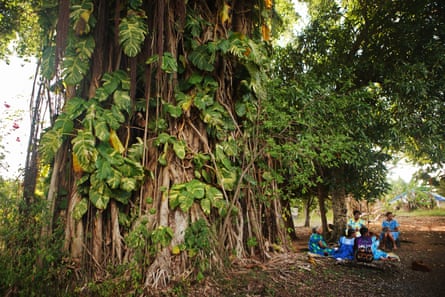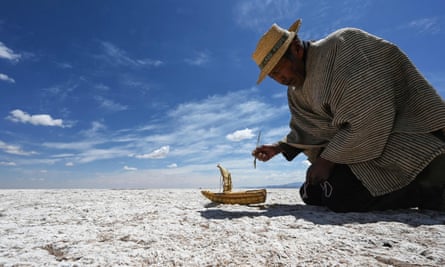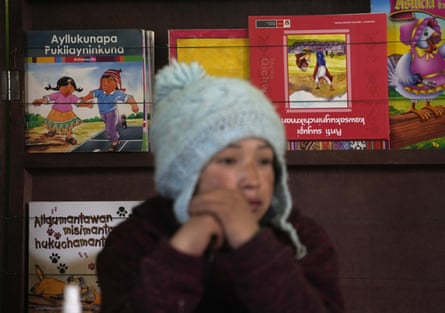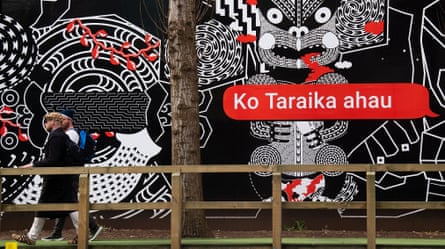Every 40 days a language dies. This “catastrophic” loss is being amplified by the climate crisis, according to linguists. If nothing is done, conservative estimates suggest that half of all the 7,000 languages currently spoken will be extinct by the end of the century.
Speakers of minority languages have experienced a long history of persecution, with the result that by the 1920s half of all Indigenous languages in Australia, the US, South Africa and Argentina were extinct. The climate crisis is now considered the “final nail in the coffin” for many Indigenous languages and with them, the knowledge they represent.
“Languages are already vulnerable and endangered,” says Anastasia Riehl, the director of the Strathy language unit at Queen’s University in Kingston, Ontario. Huge factors are globalisation and migration, as communities move to regions where their language is not spoken or valued, according to Riehl.
“It seems particularly cruel,” she says, that most of the world’s languages are in parts of the world that are growing inhospitable to people.
Vanuatu, a South Pacific island nation measuring 12,189 sq km (4,706 sq miles), has 110 languages, one for each 111 sq km, the highest density of languages on the planet. It is also one of the countries most at risk of sea level rise, she says.

“Many small linguistic communities are on islands and coastlines vulnerable to hurricanes and sea level rise.” Others live on lands where rising temperature threaten traditional farming and fishing practices, prompting migration.
“When climate change comes in, it disrupts communities even more,” says Riehl. “It has a multiplier effect, the final nail in the coffin.”
Although the effects of global heating on language have not been well studied, it has caused increased instances of heatwaves, droughts, floods and sea level rise, which have already exposed millions of people to food insecurity, water shortages and driven them from their homes. Disasters, the majority of them weather related, accounted for 23.7m internal displacements in 2021, up from 18.8m in 2018. Over the past 10 years, Asia and the Pacific were the regions most affected by displacement worldwide, with the Pacific island states the worst by population size.
Yet, it is precisely here where many Indigenous languages have thrived. One in five of the world’s languages are from the Pacific, according to the New Zealand Māori language commission.
“The Pacific, including the Philippines, India and Indonesia, has a lot of linguistic diversity. Some languages only have a few hundred speakers,” says Anouschka Foltz, an associate professor in English Linguistics at the University of Graz, in Austria.
“If sea level rise or another climate impact hits, they have to leave. Communities scatter to places where their language is not valued.”

A map of the world’s 577 critically endangered languages reveals clusters around equatorial Africa and in the Pacific and the Indian ocean region.
In response to the crisis, the UN launched the International Decade of Indigenous Languages in December. Preserving languages of Indigenous communities is “not only important for them, but for all humanity,” the UN general assembly president, Csaba Kőrösi, said, urging countries to allow access to education in Indigenous languages.
“With each Indigenous language that goes extinct, so too goes the thought, the culture, tradition and knowledge it bears,” said Kőrösi, echoing the sentiments of Ken Hale, the late US linguist and activist, who compared losing any language to “dropping a bomb on the Louvre”.
Dr Gregory Anderson is director of the Living Tongues Institute for Endangered Languages, an organisation at the University of South Africa that documents and records endangered languages.
“We are heading for a catastrophic language and cultural loss into the next century,” he says.
Anderson notes that the death of a language, when the last fluent speaker dies, is often the result of “some sort of assault” on Indigenous communities. It can be overt, such as when Indigenous children were forced into boarding schools and banned from speaking their native language in countries including the US, Canada, Australia and Scandinavian nations in the 1900s, or covert, where people with a strong accent are excluded from jobs.
Studies show that, while the suppression of Indigenous language is associated with mental health problems, the reverse can also be true. One study in Bangladesh showed that Indigenous youth capable of speaking their native language were less likely to consume alcohol or illicit substances in risky amounts, and were less exposed to violence.

There are some bright spots, too: such as New Zealand and Hawaii, where Indigenous languages have been resurrected.
In the 1970s, only 2,000 native speakers of Hawaiian remained, most in their seventh decade of life, but advocates launched “immersion schools”, where children are taught in Hawaiian. Today, more than 18,700 people speak it. In New Zealand, only 5% of young Māori people spoke the language in the 1970s, but due largely to efforts by the Māori, backed by the government, more than 25% now speak it.
Prof Rawinia Higgins, a member of the Global Taskforce for the International Decade of Indigenous Languages 2022-2032 and the New Zealand Māori language commissioner says: “Indigenous languages are an anchor to the past, as well as a compass to the future. Thirty-five years ago, people fought to save the Māori language with the government of the day boldly making it an official language protected by law. Once banned and seen by many as worthless, now more than eight in 10 of us see it as part of our identity as New Zealanders.”
The New Zealand broadcaster, journalist and Māori interpreter Oriini Kaipara was taught the language by her grandparents, in kōhanga reo, or “language nests” where only Māori is spoken.

“My generation were fortunate enough to be raised in total immersion,” says Kaipara, who, as a primetime newsreader with a Māori chin marking, or moko kauae, has become an ambassador for Māori. “But language loss is still a huge threat to us. Those generations who were native speakers, held the customs, the understanding, the indigenous knowledge that was handed down by their parents. And that has gone.”
Māori have a “unique way” of connecting with their environment that is only accessible through their language, she says. The word matemateāone is almost untranslatable into English, she said, but expresses “a deep, emotional, spiritual, physical” longing for the Earth. “In essence, it means I belong,” she says. “My language is a gateway to my world.”